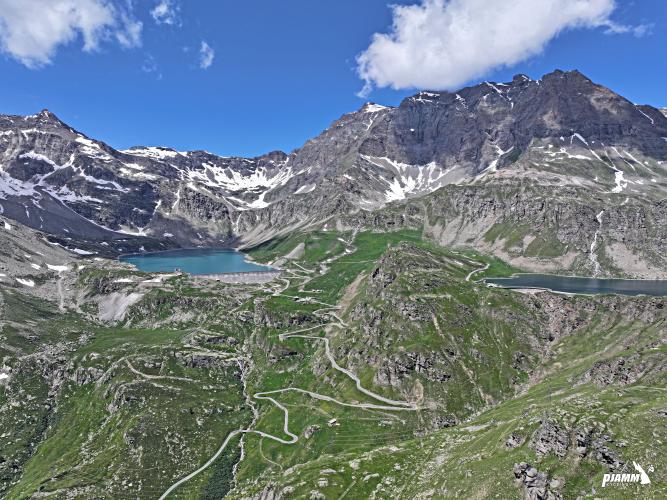
INTRO
PLAN YOUR ROUTE
 We've partnered with Sherpa-Map.com to bring you the best route planning tool. With a PRO Membership you can use this climb as a reference when creating your route.
We've partnered with Sherpa-Map.com to bring you the best route planning tool. With a PRO Membership you can use this climb as a reference when creating your route. ROUTE MAP



 We've partnered with Sherpa-Map.com to bring you the best route planning tool. With a PRO Membership you can use this climb as a reference when creating your route.
We've partnered with Sherpa-Map.com to bring you the best route planning tool. With a PRO Membership you can use this climb as a reference when creating your route. 
Cycling Colle de Nivolet, Italy.
A World Top 10 Most Scenic Bike Climb.
OH MY! Yes, this is a MUST DO climb, no doubt about it. This route has been described as one of the most beautiful climbs you have never heard of. However, judging from the many cyclists we encountered on the route on an early September Monday, the secret is out! The last third of this climb is among the most spectacular and breathtaking you will ever find. We were blessed with perfect weather, clear skies and blooming wildflowers for our one shot at this jewel.
We begin in the small, quaint village of Locana at the Parco Nazionale Grann Paradiso Visitor Center. Here, you can obtain information about the park, including roadway and hiking routes. There is another Visitor Center in Ceresole Reale (western end of Lago di Ceresole) at about mile 13/kilometer 21, although it was closed at noon when we arrived.
Locana Visitor Center- climb’s start.
The first set of hairpins encountered on the climb are in Planchette at kilometer 13.4.
This is the longest top climb in Italy. The first 17 miles (27 kilometers) have their steep sections, but for the most part are not too difficult, averaging 5% over that long stretch. Once we are in sight of the second set of major switchbacks as we approach the dam at Lago Serro, the grade begins to increase for good, with the final 8 miles(12.8 kilometers) a 50% greater average grade at 7.5% with a fair amount of that approaching and entering double digit territory.
This tunnel is 3,534 meters (2.2 miles).
At kilometer 14.8 we enter a very long 3,200m (2 mile) tunnel. There are no warnings or restrictions for bicycles as you see on some roads and tunnels. However, the tunnel is dangerous and should be avoided.
Alternative Route: The Old Road
Old road -- alternate route around tunnel.
The old road is to the right, about 100 meters before the tunnel – take that! The tunnel is terrifying and dangerous and is to be avoided at all costs. Additionally, the old road is unique and interesting - adding to the allure of this climb.
Boulder blocked our way in 2017, but was removed for the 2019 Giro d’Italia.
The old road is an experience unto itself. We travel along a river to our right on a worn and broken stretch of pavement, previously past a huge boulder that blocks all but a skinny cyclist. The 2019 Giro d’Italia featured a mountain finish at the Turino dam on the Colle del Nivolet route on Stage 13, meaning that the giant boulder that blocked our way in 2017 was removed.
The extraordinary nature of the climb begins around kilometer 21 as we reach the beautiful lake and recreational area of Lago Ceresole, two kilometers after the end of the tunnel alternate route. We spent at least an extra hour on this climb stopping to take photographs – we kept telling ourselves, “OK, this is the last set of photos, we have to get going,” but inevitably we didn’t travel much further until stopping again to take more photos of spectacular once-in-a-lifetime views.
Middle segment of the climb is through a lovely alpine setting.
The road above Lake Ceresole was unpaved when the blockbuster movie Italian Job was filmed in the late 1960’s.
We encounter 16 hairpins in a stunning setting as we approach Lago Serru and Torino Dam.
Hairpins leading to the dam and lake - 4.3 kilometers averaging 8.6% grade.
This lake services the city of Turin.
Stage 13 of the 2019 Giro d’Italia finished at the dam.
Ilnur Zakarin (RU) won stag 13 of the 2019 Giro (he finished the Giro #10 that year).
Photo: Cyclist.co.uk
The final 5 kilometers of the climb are what secure Nivolet’s spot as the #1 world most scenic road bike climb.
We pass the glacier formed Lago Serru and Lago Agnel at kilometer 33.
The final set of 14 hairpins after the lakes are 3.5 kilometers at 7.5% and offer some of the most beautiful views you’ll ever see on a bike.
Finish at the Colle del Nivolet sign.
Photo left: final hairpins to the Colle; photos right is the finish.
Hike to the summit by taking the trail to the right of the Colle sign.
This is one worth traveling to – it is a Must-Do Bucket List Climb that words simply cannot describe – photos are a good indicator, but not an adequate substitute for climbing what we consider to be The Most Beautiful Climb in the World.